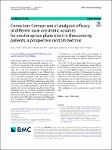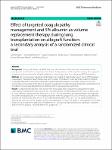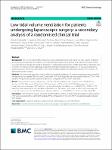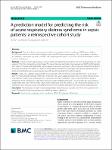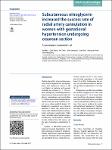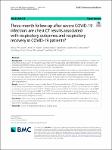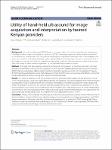Search
Author
- Osman, Ahmed I. (5)
- Daqing, Ma (3)
- Jorgensen, Ed (3)
- Li, Yan (3)
- next >
Subject
- kinh tế (26)
- Economics (12)
- programming (10)
- XRD (10)
- next >
Date issued
- 2020 - 2025 (2129)
- 2010 - 2019 (129)
- 2000 - 2009 (9)
- 1999 - 1999 (1)
Has File(s)
Search Results
I read with great interest the article “Association between blood pressure and the risk of biopsy-induced endobronchial hemorrhage during bronchoscopy” by Wang et al., It provides great insight into the hypertension and bleeding risk in a specific category of bronchoscopy procedure—endobronchial biopsy, in a specific population—lung malignancy. But I would like to offer the following comments. |
Correctly cite ‘To our knowledge, there are no studies comparing ESPB block applications using different local anesthetic volumes after thoracotomy. However, in a case series with different volumes, it was reported that the block level increased up to 9 dermatomes in a case in which 30 ml of local anesthetic was applied [4]. In studies conducted to determine the optimal level at which volume expansion can be achieved, it has been shown that this volume varies in a wide range such as 2.5 mL/ and 6.6 mL per dermatome, while the median value is 3.4 mL [5]’ should be in the form. |
A recent landmark randomized controlled trial (RCT) in septic patients demonstrated an increased risk of death and persistent organ dysfunction with intravenous Vitamin C (IVVC) monotherapy, which represents a disparate result from previous systematic reviews and meta-analyses (SRMA). We performed an updated SRMA of IVVC monotherapy to summarize and explore heterogeneity across current trials and conduct trial sequential analysis (TSA) to guard against type-I or type-II statistical errors. |
Primary graft dysfunction (PGD) after lung transplantation (LuTx) contributes substantially to early postoperative morbidity. Both intraoperative transfusion of a large amount of blood products during the surgery and ischemia–reperfusion injury after allograft implantation play an important role in subsequent PGD development. |
We recently reported the results for a large randomized controlled trial of low tidal volume ventilation (LTVV) versus conventional tidal volume (CTVV) during major surgery when positive end expiratory pressure (PEEP) was equal between groups. We found no difference in postoperative pulmonary complications (PPCs) in patients who received LTVV. However, in the subgroup of patients undergoing laparoscopic surgery, LTVV was associated with a numerically lower rate of PPCs after surgery. We aimed to further assess the relationship between LTVV versus CTVV during laparoscopic surgery. |
The risk of death in sepsis patients with acute respiratory distress syndrome (ARDS) was as high as 20–50%. Few studies focused on the risk identification of ARDS among sepsis patients. This study aimed to develop and validate a nomogram to predict the ARDS risk in sepsis patients based on the Medical Information Mart for Intensive Care IV database. |
Radial artery cannulation helps to maintain the stability of maternal hemodynamics and reduce complications; however, it is difficult for women with gestational hypertension. Subcutaneous nitroglycerin was found to improve the first attempt success rate of radial artery cannulation in pediatric patients. Therefore, this study evaluated the effect of subcutaneous nitroglycerin on the radial artery diameter and area, blood flow rate and the success rate of radial artery cannulation in women with pregnancy-induced hypertension. |
CT Severity Score (CT-SS) can be used to assess the extent of severe coronavirus disease 19 (COVID-19) pneumonia. Follow-up CT-SS in patients surviving COVID-19-associated hyperinflammation and its correlation with respiratory parameters remains unknown. This study aims to assess the association between CT-SS and respiratory outcomes, both in hospital and at three months after hospitalization. |
Utility of hand-held ultrasound for image acquisition and interpretation by trained Kenyan providers Point-of-care ultrasound (POCUS) plays a prominent role in the timely recognition and management of multiple medical, surgical, and obstetric conditions. A POCUS training program for primary healthcare providers in rural Kenya was developed in 2013. A significant challenge to this program is the acquisition of reasonably priced ultrasound machines with adequate image quality and the ability to transmit images for remote review. The goal of this study is to compare the utility of a smartphone-connected, hand-held ultrasound with a traditional ultrasound device for image acquisition and interpretation by trained healthcare providers in Kenya. |
The book presents new results of research advancing the field and applications of modulation. The information contained herein is important for improving the performance of modern and future wireless communication systems (CS) and networks. Chapters cover such topics as amplitude modulation, orthogonal frequency-division multiplexing (OFDM) signals, electro-optic lithium niobate (LiNbO3) modulators for optical communications, radio frequency signals, and more. |


